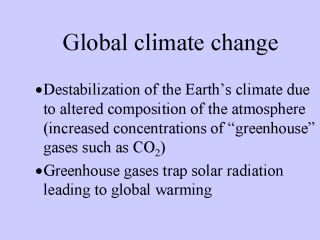 |
In recent
decades, world-wide per capita use of natural resources, social inequalities and
population numbers have all increased steeply. The combined effect of these changes has
been a rapid increase in the size of the "footprint" left by humanity on the
global environment. One of the clearest signs of this “footprint” is the change in
atmospheric composition which has occurred since the 19th century. For example,
levels of CO2, an important greenhouse gas have increased from 280 parts per
million by volume (ppmv) in 1800 to 358ppmv in 1994. Greenhouse gases such as CO2
are produced principally from the burning of fossil fuels. They trap solar radiation,
leading to global warming. |
